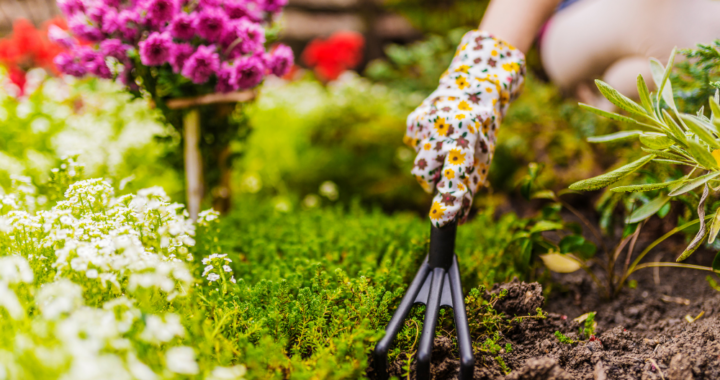Our northern climate is notorious for extreme cold, high winds, and heavy snowfall, which can wreak havoc on our lawns and gardens. However, mild winters are arguably harder on our landscaping than harsh winters. Not as many weed seeds, pests, and fungus die off, and grubs get to work even earlier, chomping at the roots of our grass and plants. Regardless of the winter’s elements, a DIY gardener has a big job to do every spring to prepare their spring landscaping for the warmer months ahead!
Spring landscaping prep is important.
Philip Stanhope said it well when he said, “Whatever is worth doing at all is worth doing well.” This certainly applies to landscaping and lawn maintenance. When we put in the work upfront, we reap the benefits of a lush, beautiful lawn and colorful, prolific gardens all spring, summer, and fall. Spring landscaping prep requires careful planning and execution but doesn’t have to be overwhelming. Take it in stride with these helpful tips!
Begin by assessing your yard and prioritizing tasks.
Assess the current state of your yard and landscaping beds and identify areas that need attention.
- Do you have broken branches dangling from your trees or strewn around your yard?
- Are there dead patches of grass in the middle of your lawn?
- Are the leaves you covered your beds with last fall decomposed and compacted on top of your mulch?
- Is your mulch thin and dispersed?
- Is there a lot of old growth to trim to make way for this season’s greenery?
As you walk around your yard, compile a list of tasks. Then put them in priority order. This will make the process a whole lot less daunting and help you plan ahead so you have all the tools you need to get the job done.
Start checking those boxes!
Now that you have your comprehensive list in hand and your tools at the ready, it’s go time!
Rake the lawn and clean out the garden beds.
Think of raking as clearing your slate and starting fresh. With either a rake or a thatcher, rake up dead grass and any matted leaves on your lawn. Then, using a rake, clean out your garden beds, carefully preserving as much of your mulch as possible. Are any perennials already poking through? Do you see any plants that need to be divided? Raking your beds will help you get a better glimpse of what you’re working with so you know how to proceed.
Prune trees and bushes.
There’s always spring pruning to attend to! Start by assessing trees, shrubs, and bushes. Trim any dead, broken branches. Then, take a look for overgrowth. Which limbs and branches are overgrown and starting to look gangly or shadowing nearby plants from the sun and water they need to thrive? Trim those back as well. Do you have any trees or bushes that didn’t produce well last year? Consider pruning them back for fuller, healthier growth this season!
A word of caution: Don’t prune spring bloomers, like lilacs or magnolias, until early summer when they’re finished blooming and petals have shriveled and dropped.
Apply Fertilizer.
Spring is the time to set your grass up for success! Have your soil tested so you know if it needs fertilizer and, if so, what type of fertilizer it requires. If you blindly fertilize your lawn, you could fry your grass and plants.
A word of caution: If you have dogs or other outdoor pets, make sure you choose a pet-safe fertilizer.
Apply Herbicide.
Did you know that you can kill weeds preemptively? Yep, nip weeds in the bud by applying preventive herbicide. Should some pesky weeds persist, dig them up or spray them with spot treatment.
A word of caution: If you have dogs or other outdoor pets, make sure you choose a pet-safe herbicide. (Yes! It does exist!)
Edge your lawn.
Few things will make a greater impact on curb appeal than edging your lawn. If you don’t have an edger, you can always rent one from your local rental store. Follow along your sidewalk, driveway, and any walkways on your property. Be sure to edge along your garden beds as well! Not only will it look sharp, but it will keep mulch from overflowing onto your lawn.
Reseed bare patches.
Whether your dog did his business on your lawn instead of in the woods, you forgot to move your trampoline around the yard last year, or frost killed patches of your grass and your lawn looks like it has mange, bare spots happen. If you’re not applying a pre-emergent herbicide, spring is an excellent time to reseed those bare spots so they can be full and lush by summer. Start by killing any existing grass or weeds in the patch you want to reseed. Then loosen up the top ¼ inch of soil and distribute the grass seed evenly over the dirt at the density recommended on the bag. Lastly, fertilize your grass seed and be sure to water it daily.
Freshen up your mulch.
Whether you fluff your current mulch and add new mulch on top or swap it out altogether, freshening up your mulch competes with edging your lawn for curb appeal impact! We recommend a 3-4’ layer. But mulch isn’t just for aesthetics. Mulch helps control moisture, discourages weed growth, and adds nourishment to your soil.
Feeling overwhelmed? McDonough can help!

If you don’t want to go at it alone, we offer two spring maintenance packages:
Planting Bed Start-Up Package:
This package includes pruning, light cultivation of mulch, and a general clean-up of all planting beds. We will remove old perennial growth and residual fall leaves. We will also apply a slow-release granular weed preventer and a spring fertilizer. We will check and trim edging lines as needed.
Planting Bed Topdressing Package:
With this package, we apply a fresh top-layer of premium shredded wood mulch. Purchase this package in conjunction with the Planting Bed Start-Up Package or as a standalone.
Do you love your gardens but dread the upkeep? We also offer a weekly or monthly maintenance service from May-October where we prune, cultivate, weed, fertilize, and monitor the health of your plants.
Ask us about our spring and season-long maintenance packages!
